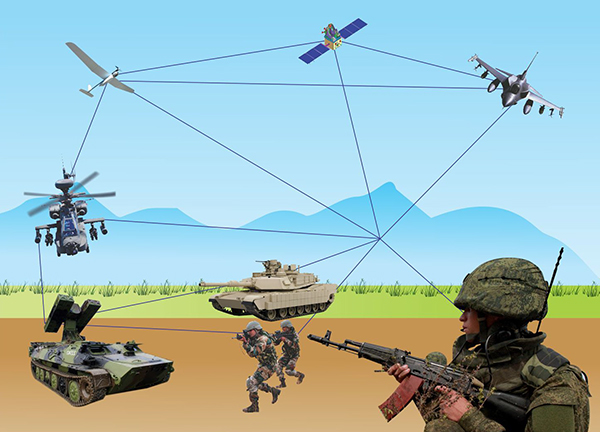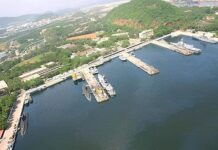Gen BPS Rawat, PVSM, UYSM, AVSM, YSM, SM, VSM, ADC
Extracts of the Inaugural Address delivered by Gen Bipin Rawat, Chief of Defence Staff, at the Digitisation& Networking in the Armed Forces 2020 webinar on 21 Nov 2020.
The manner in which we will be conducting warfare in the future is fast changing. With the revolution in military affairs and technology, we need to shape our concept of operations (conops) and with that the manner in which we will raise, train and sustain our armed forces. The militaries need to completely undergo transformation. Our armed forces are on the cusp of transformation through integration. Modernisation, in line with the global security environment and utmost optimisation of resources for greater combat effectiveness is, therefore, a must.
In today’s world, multilateralism, technology challenges, climate change, democracies and its manifestations are the new norm of geopolitics and geo-economics. Technology infusion is the buzz word and needs specialisation and continuity. Nations are aware that control over technology defines economic, political and nation’s military power and, hence, are aggressively protecting national innovation bases. Warfare is changing and so are the threats, especially for us in India. There are collusive threats from our neighbourhood nations, border intrusions across terrestrial borders and the new phenomenon of multi-front warfare spanning borders, electronic and the cyber domain.
The phenomenon of narrative driven news or fake news and the instant nature of news-gathering and dissemination through the social media is a complex challenge. National security may be adversely impacted by the spread of false news by hostile elements within and outside the country using the social media network. Global pandemic, ecological degradation and climate change has significant impact on national security as it may lead to social disruption and economic distress undermining domestic security, something that we are witnessing in the difficult and challenging times of Covid.
Character of Warfare
New technologies are changing the very character of warfare and providing innovative base to execute new forms of warfare in the non-contact domain that includes information operations, espionage, stealing intellectual property rights, economic inducements, etc, all backed up by clever propaganda and fake news to justify actions.
The process of disruptive technologies like artificial intelligence (AI), robotics, non technology, Big Data analytics, drone technology, autonomous unmanned systems, militarisation of space, cyber warfare, quantum communications, along with manipulation of social media, are leading the new threats further complicating the security environment.
AI and quantum computing are being used to produce sophisticated autonomous weapons that may accelerate the pace of combat with destabilising consequences. While these technologies are constantly reshaping the contours of the threat, they also provide us an opportunity to acquire new enabling military capabilities for strategic advantage. The armed forces must, therefore, be prepared for a future conflict with its changed character. Recent example being the drone orbiting Armenian and Nagorno-Karabakh soldiers and destroying their tanks, artillery and air defence systems by the Azerbaijan forces during the past few weeks of the war. This war offered the clearest evidence of how the battlefields can be transformed by an expanding array of low cost drones at a fraction of the cost of maintaining a traditional air force. The situation also underscores how drones can suddenly shift long standing conflicts and leave ground forces highly exposed, thus, creating an unimaginable exploitation of the field chain network.
ALSO READ: Information Warfare : Curbs on Big Tech Necessary
The rapid advances in technology reinforce and compliment the forces on land, sea and in the air, while the synergised application of military power at the theatre, operational and tactical level is the essence of winning future wars. However, the present environment and future trends indicate a host of challenges that we need to overcome. One should remain prepared to confront the growing military capabilities of our adversaries. Needless to say, we cannot fight the next war on the premise and the experiences and structures of our past wars. This mandates the armed forces to prepare for operating in an expanding horizon.
Widening operations capability generated through tri-Services integration, innovation and infusion of cutting-edge technologies, along with infrastructure development are major imperatives. We are in the process of evolving our structures and systems; a series of initiatives are being undertaken that will change the way we fight and the way we develop capabilities. Its aggregate effect will gradually build momentum. We have, therefore, set timelines for the transformation to be effective with adequate headroom for us to modernise.
Changes Taking Place
In the first year we are examining an evolving concept, which will be followed by a dedicated trial and aligning of structures. The next two years will eventuate the stabilisation of integrated structures and processes. World over integration of capabilities has taken time to evolve. Today, we are evolving structures and processes to meet the challenges of conventional and non-conventional threats. Joint study groups on integrated air defence command, integrated theatre command and maritime theatre command have brought out their papers and these are being deliberated and further refined so that firm steps can be taken to operationalise them in the next two to three years. We are also examining the feasibility of a concept of joint logistics command that would, in addition to the competencies of our Services, draw on the strengths of the existing civilian infrastructure that is fast evolving in our country.
We also need to look at our teeth-to-tail ratios and become leaner and meaner in consonance with the armed forces increasing reliance on technology like Big Data analysis, AI and our attempt at greater standardisation.
Therefore, what is the way forward for our future. The most important is capability development. In the matrix of inclusive growth of the nation, it is imperative to achieve technological progression and indigenised capability building towards self-reliance for supporting the nation’s progress on all fronts. Credibility comes from capability. Towards this, we have set for ourselves a roadmap to identify 360-degree approach of capability development and force structuring for a modernised force primed to meet emerging and future challenges.
For efficient and optimal management of the allotted budget, HQ IDS has drawn out a framework to enhance integration and jointness in capability planning. This framework of the process is termed as the Integrated Capability Development System (ICADS) and will lead to the formulation of the Integrated Capability Development Plan (ICDP). The process has been set in motion in August 2020 and the deliverables are expected by mid-2021.
What changes are we contemplating in the procurement process? Steps for streamlining the processes and structures for optimal and most efficient management of our allotted budget are being undertaken. We understand the importance of indigenisation, to achieve self-reliance in equipping our armed forces. I must acknowledge the commitment of all stake-holders including the civilian defence industry which is making adequate headway towards supplementing our modernisation efforts. A nation’s aspirations of becoming a regional power cannot rely on borrowed strengths. India’s wars have to be won by Indian solutions. Indigenisation is the way forward and we are fully committed to it. The existing segregated nature of defence and commercial industry ecosystem is stripped of capabilities and capacities for making defence equipment. Integrating civil and military technology efforts is the way forward towards self-reliance. Cooperation between government and commercial facilities in research & development, manufacturing, maintenance operations, combined production of similar components and sub-components on same production lines will optimise commercial and defence industrial base to maximise resource utilisation and reduce manufacturing and life-cycle costs of defence equipment. The recent setting up of eight technology centres by DRDO in September 2020 to carry out research in futuristic military applications and unveiling of its new procurement manual on 20 October 2020 to encourage private sector partnership are steps in this direction in sync with the government’s Atmanirbhar initiative.
The contracting envelope of the defence budget makes it all the more imperative to create dual-use infrastructure for civil-military fusion. We must examine the feasibility of integrating civil-military airports to strengthen aviation safety, airspace management and combat support capability. Satellites for remote-sensing and reconnaissance, communications, positioning and navigation must also meet requirements of the armed forces with desired inbuilt encryption. Railway wagons and civil truck trailers must be manufactured for dual use capable of transporting heavy military equipment including armoured fighting vehicles. Construction of communication towers and electric infrastructure, along with rail, roads, bridges and tunnels in border states must be of specifications that facilitate utilisation by the armed forces as well. We must look at civil-military convergence and storage and warehousing facilities for fuel, oil & lubricants, rations and ordnance supplies. Civil-military integration in infrastructure development holds the key to whole-of-nation approach towards our national security.
A road map for the future is being put in place to enhance integration and synergy amongst the Indian armed forces with timebound timelines.




















[…] Twitter WhatsApp Linkedin Email Print Previous articleDIGITAL TRANSFORMATION – Transformation For Future War IMR […]
[…] DIGITAL TRANSFORMATION – Transformation For Future War […]
[…] DIGITAL TRANSFORMATION – Transformation For Future War […]
[…] DIGITAL TRANSFORMATION – Transformation For Future War […]